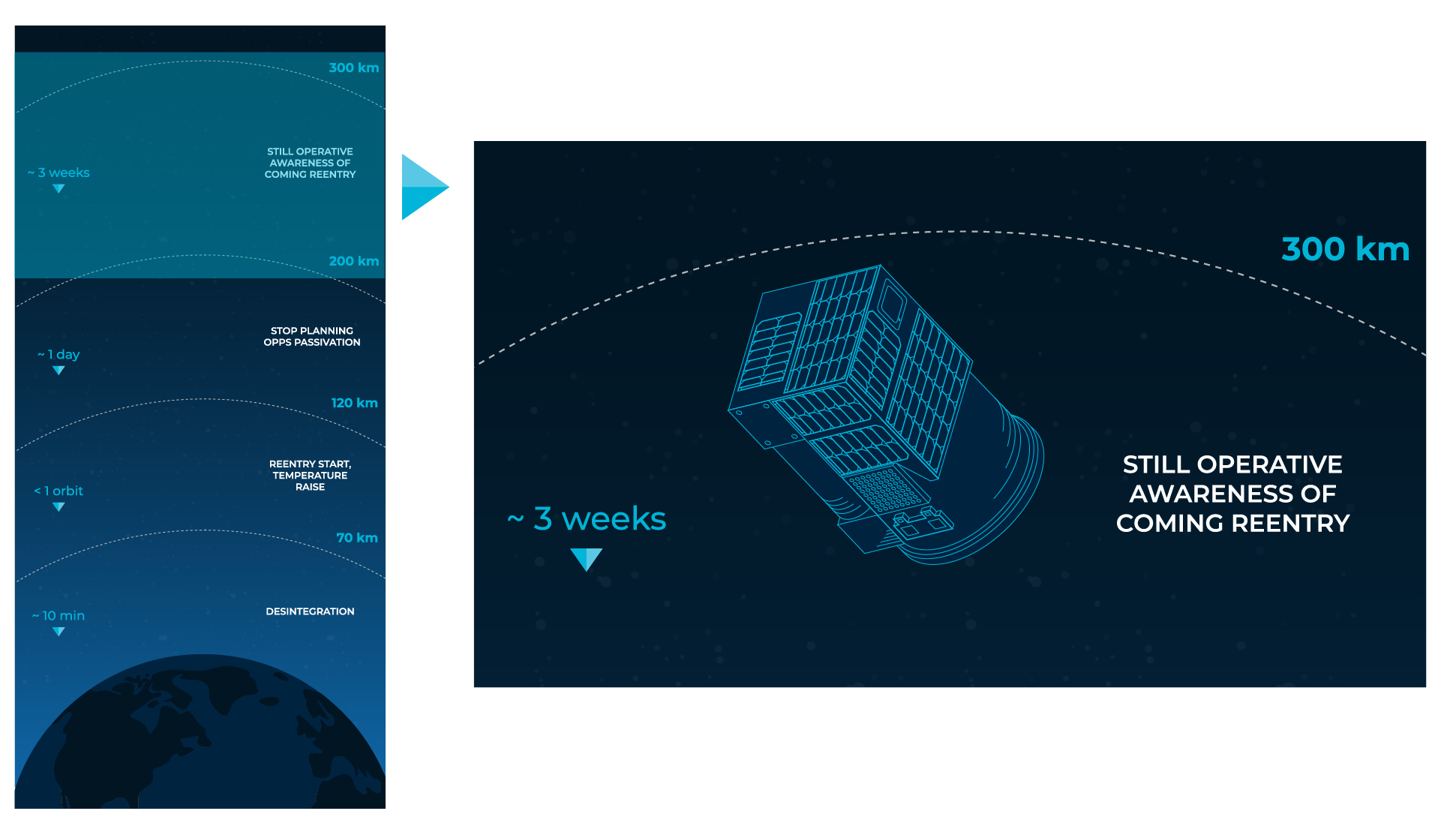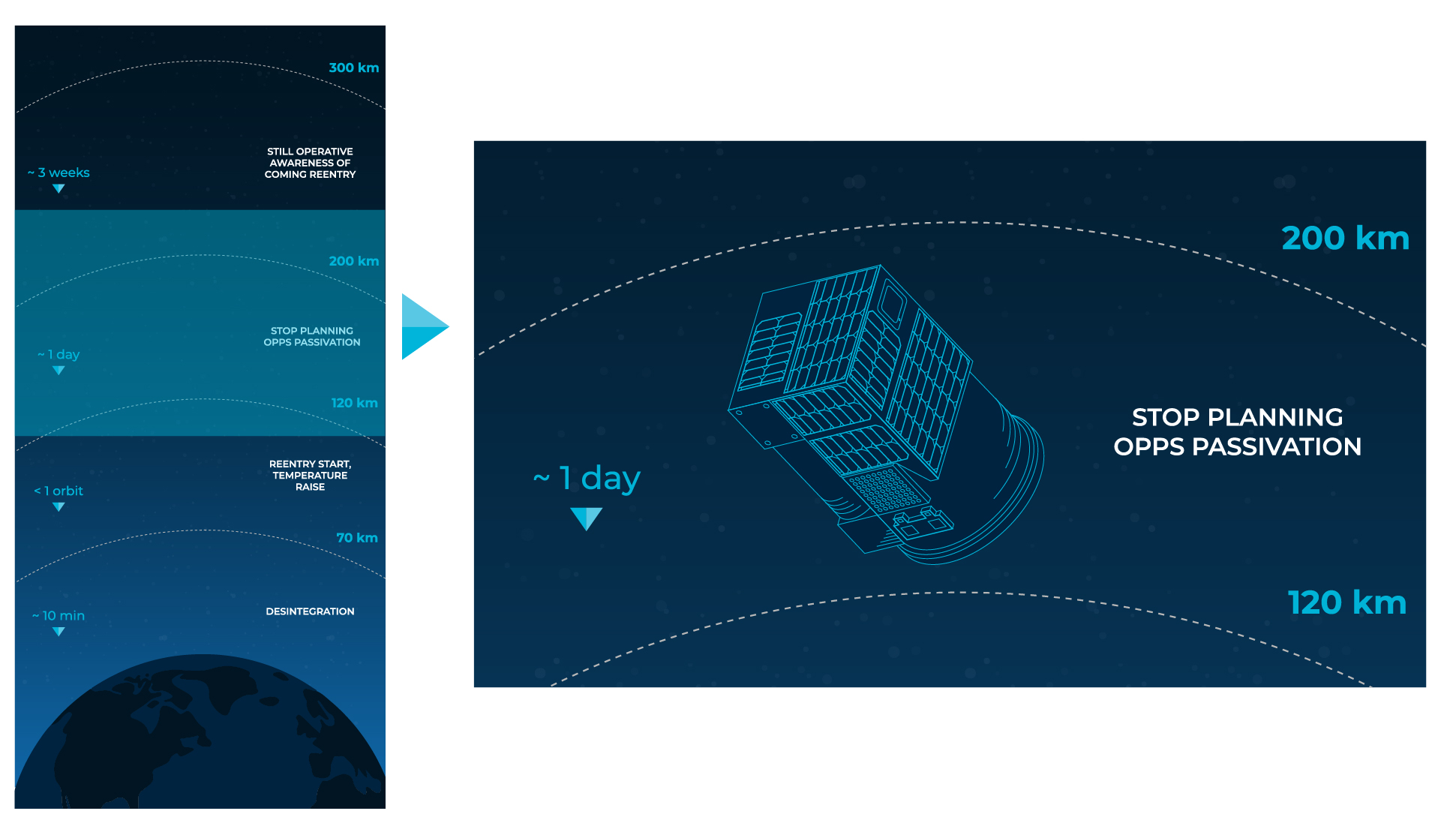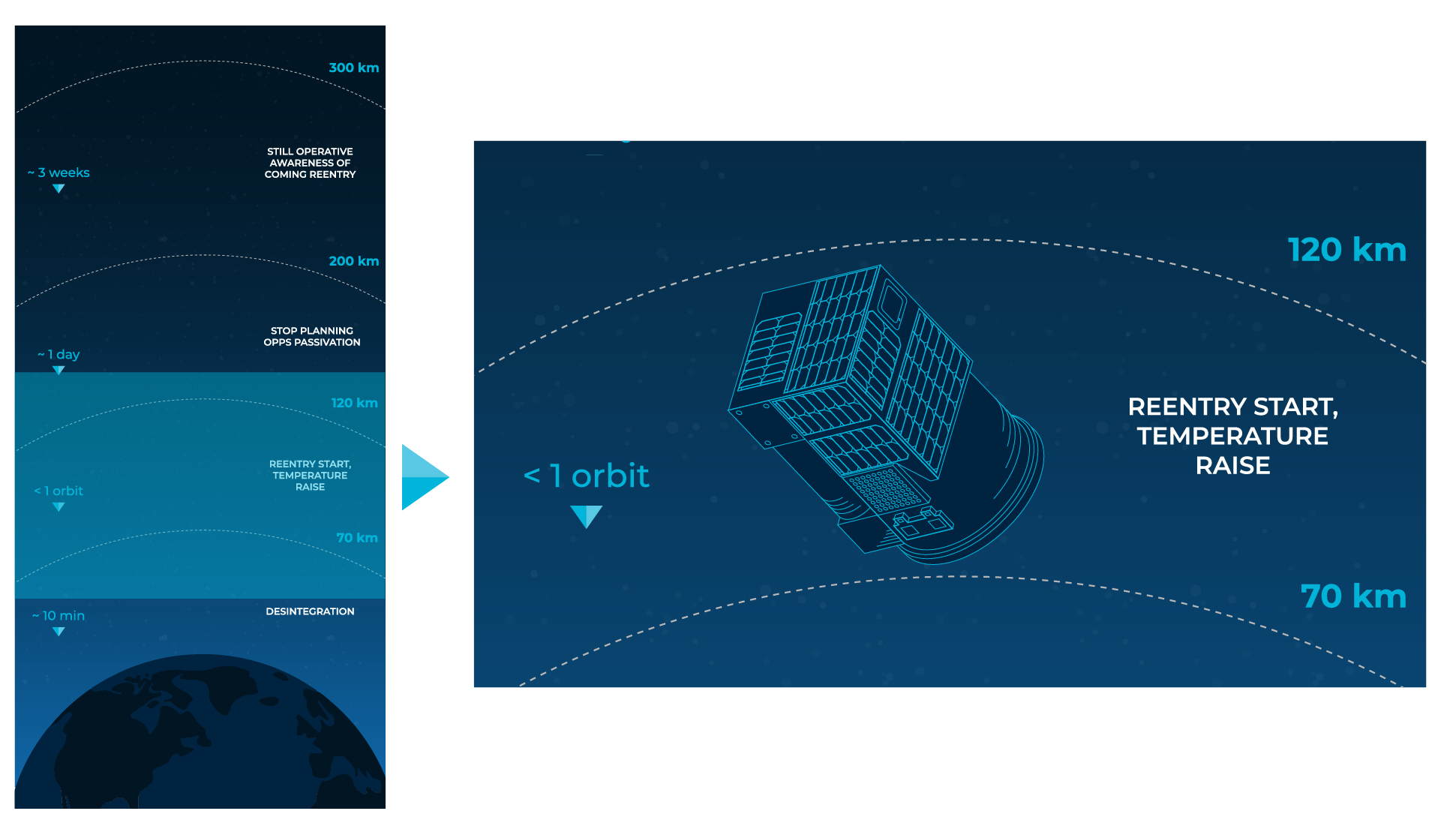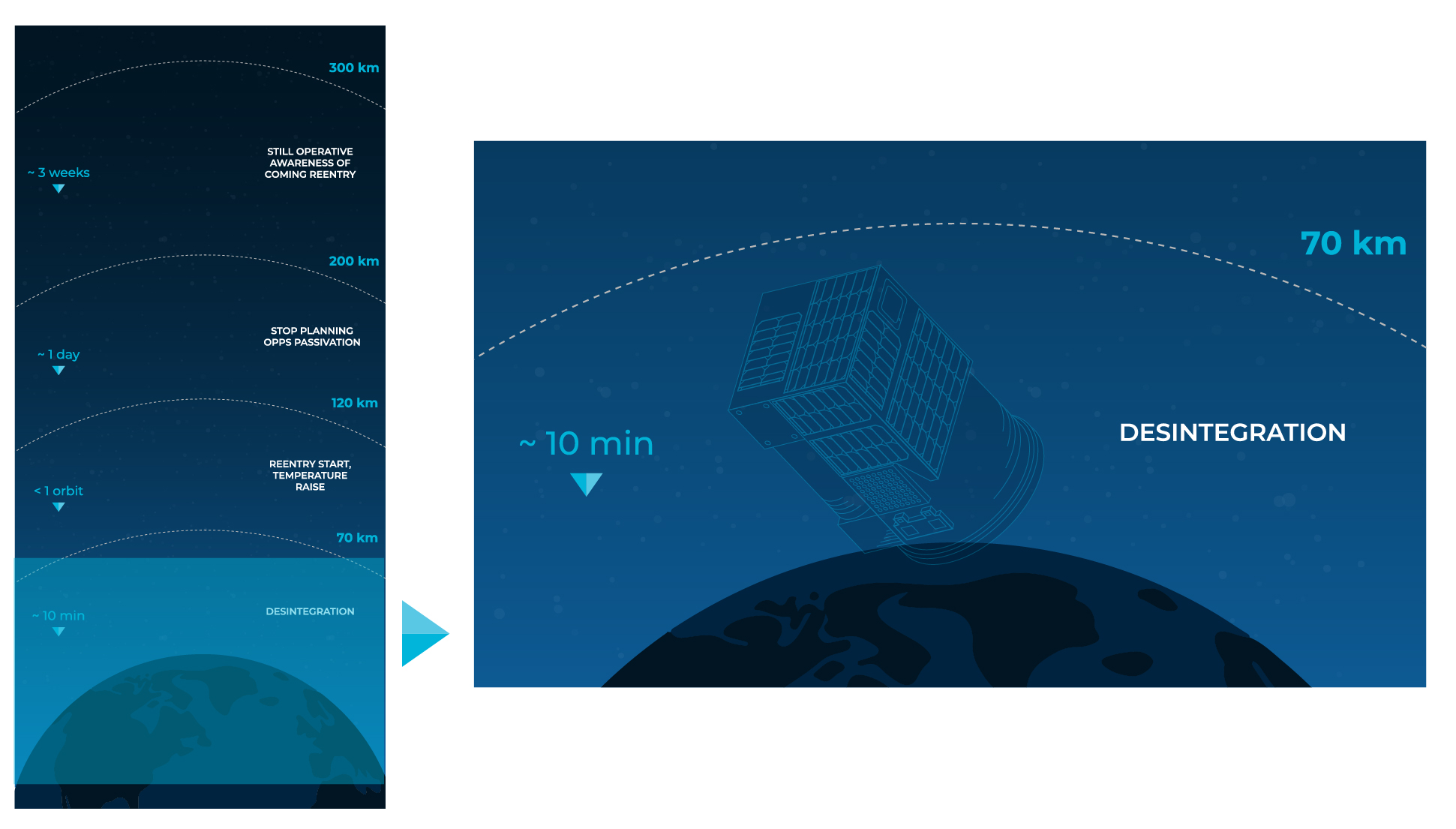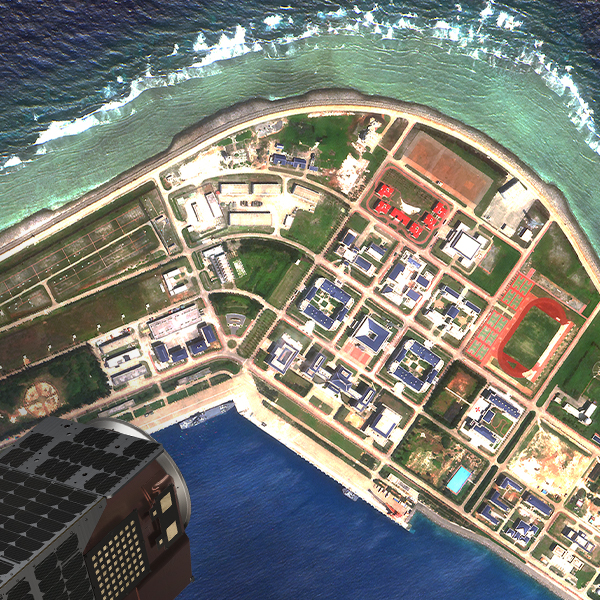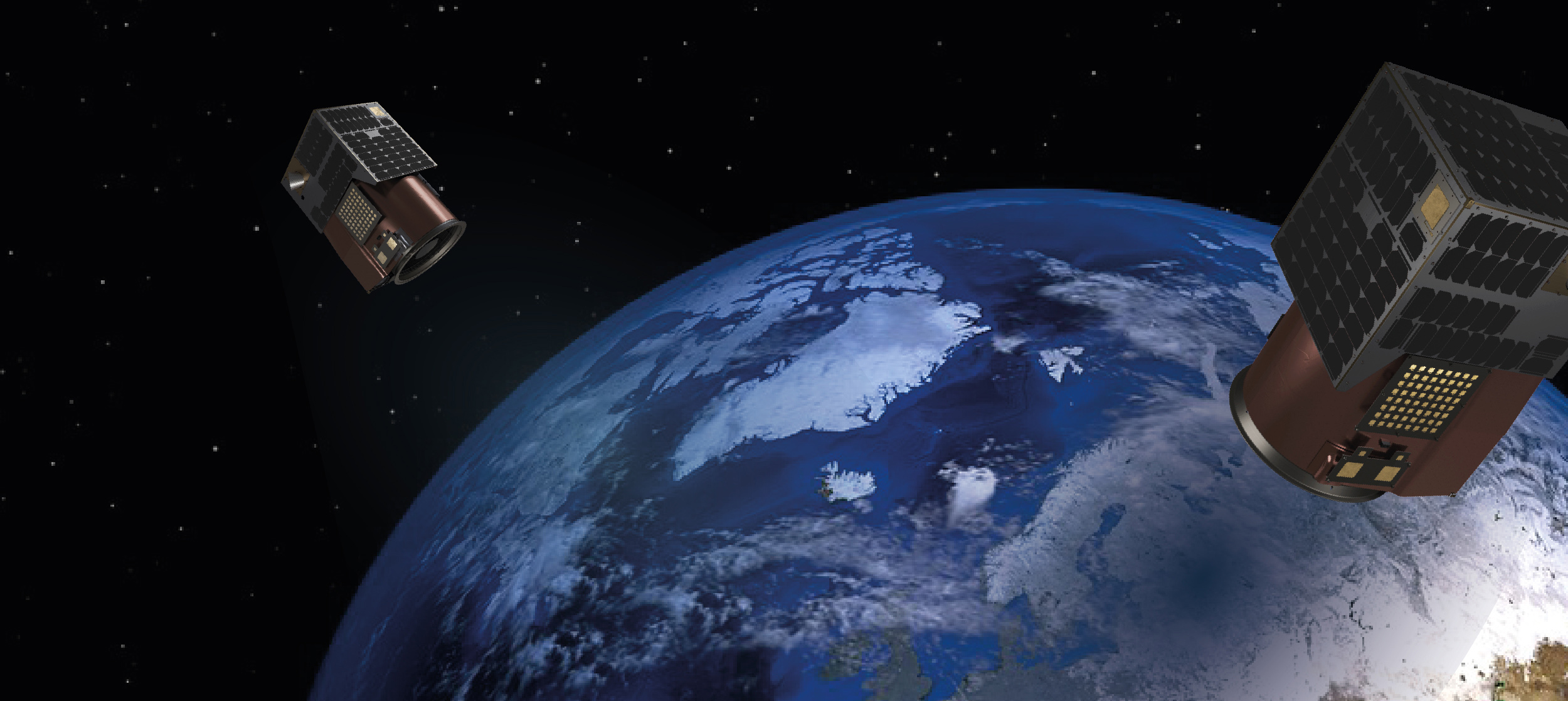
Satellogic NewSat Satellite Re-Entry Strategy
By Eloy Bauer Espitia, Lead Flight Dynamics Engineer
Spacecraft End-of-Life Protocol and Anticipated Deorbits
Life in Low Earth Orbit
A satellite’s lifetime depends on several factors, including shape, mass, and propulsion capabilities, plus operational orbit and space weather. The main player in satellite decay is the atmospheric drag. Satellites on Low Earth Orbits (LEO) are affected by free particles that hit their advancing surfaces and make them lose energy, resulting in an altitude decrease over time. This effect is not the same for all satellites, because it is proportional to the ballistic coefficient (mass divided by drag coefficient times area), as well as the local atmospheric density and satellite velocity.
To counteract the effects of satellite decay, propulsion systems are used to maintain a desired operational orbit; this is called station keeping. However, it is important to state that the life cycle of a satellite is finite and while active attitude control may delay satellite decay, LEO satellite reentries are inevitable due to atmospheric drag.
In summary, satellite lifetime is an extra design variable that is taken into account during the design process; once the defined operational orbit is selected (per payload requirements), the propulsion capabilities on the flight are designed to support the operation or orbit during the entire satellite mission as well as post-mission disposal and satellite reentry within the recommended time period.
The higher the altitude, the longer the lifetime of a satellite, generally speaking. Figure above shows the estimated timeline for satellite reentry, alongside some facts for each altitude range
Why and How Re-Entry Works
International guidelines for limiting orbital debris in space (NASA-STD-8719.14C) state that the space structures (i.e., launch vehicle components, upper stages, spacecraft, and other payloads) shall include a plan for disposal after the end of their respective mission in one of the following ways: Earth atmospheric natural reentry, direct reentry, maneuvering to a storage orbit, direct retrieval, long-term reentry or Earth scape. LEO satellites that comply with recommended orbital lifetime after mission times and don’t imply a higher threat for humans after entering the atmosphere, are selectable for doing a natural reentry
Laws of Science and Space
There are policies and protocols to protect satellites from erratic deorbiting and debris. And due to the influx in commercial space activity, these policies are evolving. What governing body regulates space? Depends on the space activity.
There are global, regional, and national agencies that uphold or are working to establish various space laws. Some of the most influential policies stem from the United Nations Office for Outer Space Affairs (UNOOSA), the International Organization for Standardization (ISO), the European Space Agency (ESA), the US National Oceanic and Atmospheric Administration (NOAA), and most recently the 19th Space Defense Squadron (SDS), a component of the U.S. Space Force. This specialty group (superseding the 18th SDS for commercial customers) focuses on Space Domain Awareness and monitors all spacecraft activity in Earth’s orbit.
Additionally, the US-based Federal Communication Commission (FCC) regulates space activity specifically related to the US government and its commercial markets. Just last year, the FCC voted to update its previous policy on deorbiting. Once providing a leeway of 25 years, spacecraft that reach end-of-life at <2,000 kilometers must deorbit as soon as practicable and no more than five years after mission-end. This policy will affect US-based spacecraft launches beginning September 2024.
Satellogic NewSat Re-Entry Strategy
As the operator of the largest commercial sub-meter resolution satellite constellation, Satellogic developed a strategic deorbiting protocol that adheres to ESA’s ESSB-HB-U-002 Date 19 February 2015 Issue 1 Rev 0 Guidelines for space debris mitigation and is in line with international recommendations for space debris mitigation and the ISO 24113:2019 standard.
NewSat satellite end-of-life disposal is done via natural decay due to atmospheric drag. This approach was selected due to the low altitude in which the satellites operate and because it does not require any functional subsystem thereby guaranteeing compliance. In our simulations, it is assumed that the reentry starts at an altitude between 120 km and 130 km, but because the attitude during this process cannot be predicted with precision we also simulate the worst-case scenario.
In our most recent self-assessment, the Satellogic Debris Mitigation plan demonstrated that the spacecraft and systems design and procedures are inline with the accepted debris mitigation standards and best practices of ESA and NASA. Risk analysis showed that human casualty risk from the reentry-surviving components of the satellites is 1.78E-5, over 5x less than the actionable threshold (1E-4).
During satellite reentry, the satellite will be exposed to high temperatures that will disintegrate its structure and expose all the components to this aggressive environment. Satellite components with lower melting temperatures will vanish into the atmosphere.
What this means
All our satellites operate in LEO at an altitude between 475 km and 530 km in Sun-Synchronous Orbits (SSO) with an inclination of about 98 degrees. Each satellite’s precise altitude in orbit is constantly monitored and adjusted periodically through station-keeping maneuvers done by the orbital dynamics control and monitoring team. The spacecraft contains propellant estimated to last 3 years, an average life expectancy subject to orbit conditions, mission, and operability. Due to its proximity to the Earth’s atmosphere, we have determined that natural decay is the re-entry strategy.
Once a satellite propellant source is depleted, the satellite is left to decay naturally and is expected to disintegrate in the atmosphere within 5 years, aligned with the new policy of 5 years and with no significant risks of person or property collision, according to safety recommendations set forth in ESSB-HB-U-002 or NASA-STD-8719.14C.
Anticipated Deorbits
Satellogic launched its first NewSat generation in 2016 and has launched additional generations nearly every year since. Each iteration include new enhancements. Our latest NewSat Mark-V spacecraft features greater power sustainability, resolution, and capacity. This generation is expected tohelp alleviate temporary changes in constellation capacity as some satellites in orbit reach their end-of-life over the next several months. As we continue to replenish our constellation with Mark-V satellites and beyond, Satellogic expects to exceed each previous capacity rate–with the goal of achieving 200+ satellites in orbit for daily global remaps.
